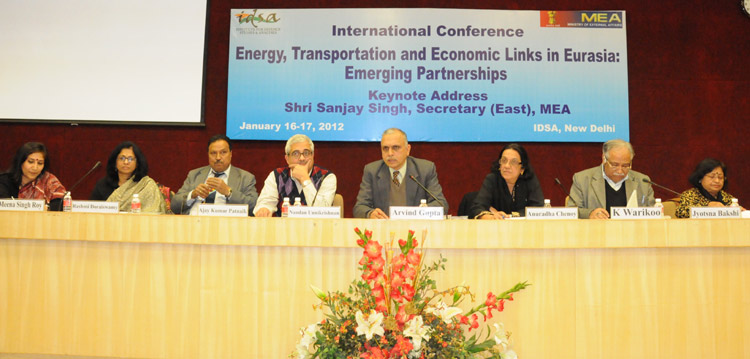You are here

Anuradha Chenoy, K Warikoo, Jyotsna Bakshi, Ajay Patnaik, Rashmi Doraiswamy, Nandan Unnikrishnan and Meena Singh Roy.
Panellists in this session came up with recommendations on India’s possible strategy in the region with specific reference to energy, transportation and economic linkages.
Prof. Chenoy argued that given India’s growing energy requirements, it is essential for the country to not put all its eggs in one basket and instead have a host of different suppliers that it can rely upon. However, the quest for energy must not make it a victim of narrow geopolitics. She dwelled on two contesting narratives in India; the nationalist narrative which calls for an independent, non-aligned foreign policy and the other, which sees such a foreign policy as irrelevant and advocates a strategic partnership with the US. Today, India is straddling somewhere between these two narratives. The country needs to be self-reliant, keep its options open and have a multiplicity of alliances and routes. India’s foreign policy needs to be based on cooperative geopolitics.
Prof. Warikoo deliberated on India’s need to engage the Central Asian countries. He argued that India’s expertise in laying pipelines and in the management and marketing of petroleum products should come in handy in its energy cooperation with the region. India should also explore the option of an energy swap deal with Iran. Moreover, India must ensure that its efforts are not sidestepped by moves made by other countries. He was of the view that feasibility of TAPI pipeline project needs to be further explored.
Dr. Bakshi dwelled on CAREC as an important multilateral platform which India can become a part of. In an age where competition and co-existence characterize the Eurasian region, India can influence the activities of CAREC by being a part of that institution. India should tread cautiously and can try emulating the Chinese example by building roads and enhancing trade with border countries. She argued that the Iran route will be very important for India and priority be given to the country’s national interest when dealing with Iran. The Mumbai cooperative organization that focuses on Maritime Eurasian trade will be important for developing India’s links with Eurasia.
Prof. Patnaik highlighted four regional energy complexes and connectivity routes that India can try to be a part of a) TAPI and b) connectivity through China. However, he was of the view that both these projects will be difficult to materialize in the near future. In the two other projects which appear feasible, notably the Chah Bahar-Central Asia-India route and Bandar Abbas- Turkmenistan-India route, role of Iran will be crucial. Moreover, there is an opportunity for India to invest in Tajikistan and Afghanistan. India can also explore the possibility of an economic agreement with the Eurasian Customs Union.
Dr. Doraiswamy deliberated on the INSTC being the most viable energy transportation route and felt that swap deals can help deepen India’s ties with countries of the region. She argued that Iran will be the gateway to Caspian Sea and Central Asia and India should undertake oil exploration in the region. There is also a need for India to move beyond energy deals by actively promoting sustainable programmes in the form of IT projects, banking, capacity-building etc. Countries of this region can study, if not emulate, India’s soft power capabilities.
Mr. Unnikrishnan argued that the task before India is to give a new direction to INSTC in order to make it commercially viable. There is a pressing need to upgrade the available infrastructure in both Russia and Central Asia. Moreover, India needs to be cautious while negotiating the TAPI project on account of security concerns in Pakistan. He suggested that the IPI pipeline can be visualized in terms of roping in China to develop counter-dependency in the region. Mr. Unnikrishnan deliberated on the need to stop treating Central Asia as a monolith since each country in the region has a unique identity and culture. In order to give a new impetus to the relationship, India’s private sector should be encouraged to engage with their counterparts in Central Asia. Instead of joining a Customs Union, India can be a part of different cooperative agreements with the Central Asian countries.
Dr. Roy envisioned three levels of engagement with Central Asia. One, at the bilateral level where a long term strategy of 15 to 20 years in economic, transportation and energy linkages is planned. High-level working groups in each of these linkages can be set up. India can become a hub for air connectivity for Central Asia. Annual conferences addressing these issues at the think-tank level should be organized as well. At the regional level, India has to inspect and analyze potential benefits of engaging with the region. India can enhance its participation in the SCO and also support engagement between SCO and SAARC. At the multilateral level, there is a need for greater will and availability of financial resources to engage the regional actors. India can assist these actors by addressing the regional security challenges.
